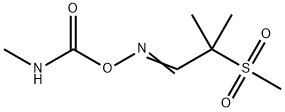알독시캅 C화학적 특성, 용도, 생산
개요
Aldoxycarb, is also called 2-mesyl-2-methylpropionaldehyde
O-methylcarbamoyloxime (IUPAC), the sulfone analog of aldicarb, is also a systemic
insecticide effective for control of insects (mainly sucking
insect pests such as aphids, leafhoppers, etc.).
화학적 성질
Aldoxycarb is a carbamate pesticide used mainly as an insecticide and acaricide. It
is a white crystalline powder with a slightly sulfurous odor. Aldoxycarb is extremely
toxic to wildlife. Aldoxycarb (Aldicarb sulfone) is a breakdown product of aldicarb.
Aldoxycarb is a degradate/metabolite of aldicarb produced by the oxidation of the
thio-moiety.
용도
Aldicarb Sulfone is an analog of Aldicarb (A514650) detected in agricultural products as pesticide residue.
일반 설명
White crystalline solid. Insecticide.
반응 프로필
ALDICARB-SULFONE is a carbamate ester. Carbamates are chemically similar to, but more reactive than amides. Like amides they form polymers such as polyurethane resins. Carbamates are incompatible with strong acids and bases, and especially incompatible with strong reducing agents such as hydrides. Flammable gaseous hydrogen is produced by the combination of active metals or nitrides with carbamates. Strongly oxidizing acids, peroxides, and hydroperoxides are incompatible with carbamates.
건강위험
Exposures to high levels of aldoxycarb cause adverse health effects and damages the
nervous system of humans and laboratory animals. Chemicals that cause adverse health
effects in humans and laboratory animals after high levels of exposure may pose a risk
of adverse health effects in humans exposed to lower levels over long periods of time.
Ingestion and other exposures to the chemical cause various health disorders. The type
and severity of symptoms varies depending on the amount of chemical involved and
the nature of the exposure. The symptoms include, but are not limited to, eye irritation,
skin irritation, dizziness, sweating, malaise, CNS depression, abdominal pain, diarrhea,
nausea, vomiting, salivation, headache, ataxia, muscle twitching, muscle weakness,
runny nose, tearing eyes, pinpoint pupils or dark vision, wheezing, increased or
decreased heart rate, seizures, convulsions, and death. It has not caused any delayed
neurotoxicity in animals. The onset of these symptoms is rapid and the severity of
symptoms depends on the dose. The immediate cause of death is usually respiratory
failure.
농업용
Insecticide, Acaricide, Nematicide: Used to control honey locust, gall midge and other
insects and mites on cotton, potatoes, sugar beets and
ornamentals. Applied to the soil by soluble mixture or
spikes. Not listed for use in EU countries.
상품명
ALDICARB SULFONE®; TEMIK
SULFONE®; SULFOCARB®; STANDAK®;
UC-21865®
신진 대사 경로
Aldoxycarb is the sulfone analogue of aldicarb. It has now been superseded
but, because of its close relationship with aldicarb, it is included
here. The degradation and metabolic pathway of these two structurally
related compounds are consistent with each other. Information on the
metabolism of aldoxycarb discussed in this summary is based on results
obtained from studies where aldoxycarb was the test substance. Additional
information can be obtained from the aldicarb summary. The
metabolism of aldoxycarb in soils, plants and animals follow common
metabolic pathways which include the hydrolysis and elimination of the
oxime carbamate to yield the corresponding oximes and nitriles. These
primary metabolites are further degraded via hydrolysis to the corresponding
amides and acids. Other reactions also include the hydrolysis/
oxidation of the oxime to the corresponding alcohol, aldehyde and acid.
Further degradation to methane sulfonic acid was observed in plants and
animals. The metabolic pathways of aldoxycarb are presented in Scheme 1.
알독시캅 준비 용품 및 원자재
원자재
준비 용품








